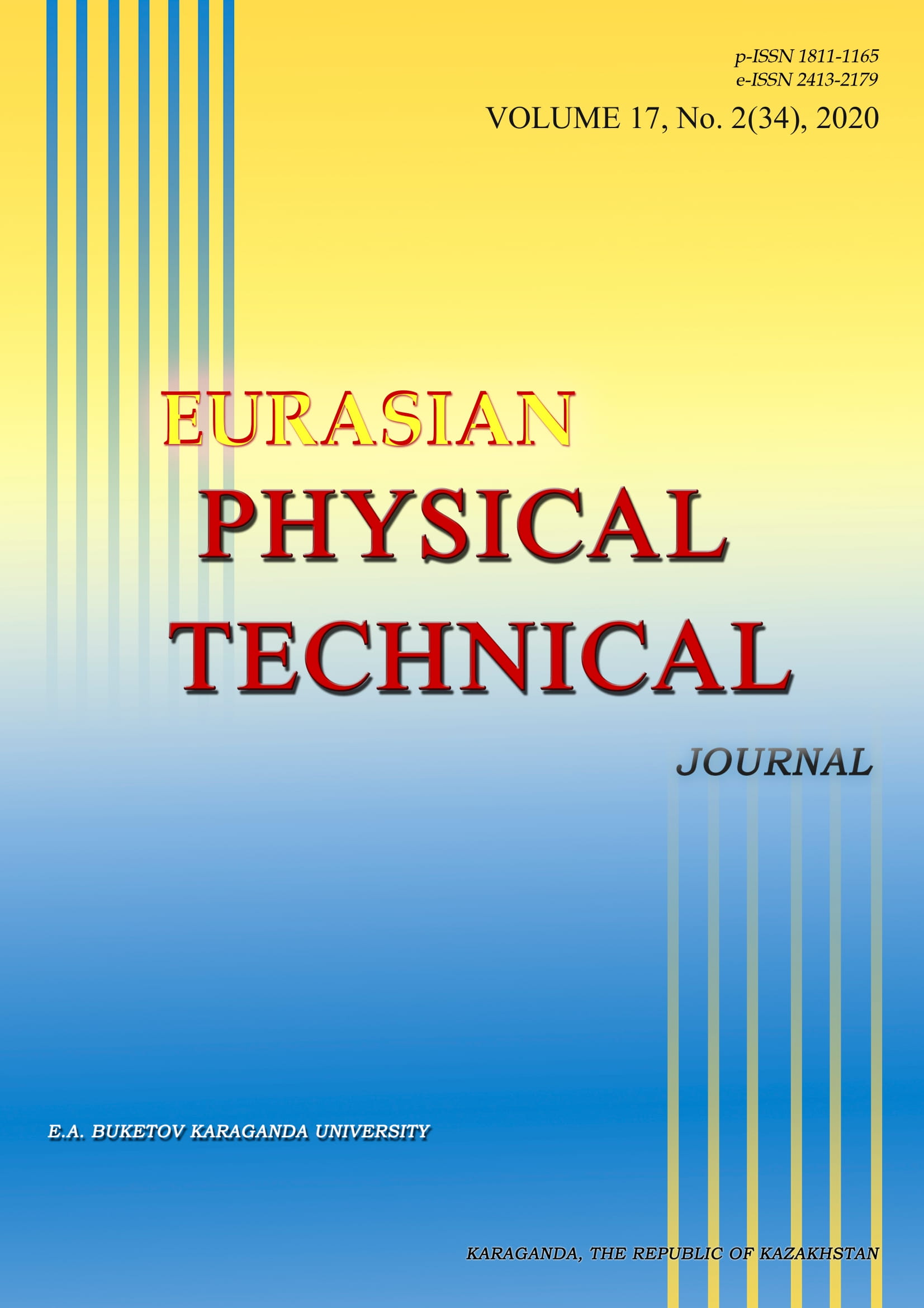Жеке жылжытылған бөлшектермен және ішінара көлеңкелеу жағдайында максималды қуатпен сенімді бақылау нүктесімен бөлшектердің үйіндісін оңтайландыру.
DOI:
https://doi.org/10.31489/2020No2/128-137Кілт сөздер:
максималды қуат нүктесін қадағалау, ішінара көлеңкелеу, мета-эвристика, бөлшектер үйірін оңтайландыруАңдатпа
"Қуатты басқарудың тиімді әдістері фотоэлектрлік жүйелерді жобалаудың ажырамас бөлігі болып табылады. Қуаттылықты басқару құралдарының бірі - тұрақты тоқ түрлендіргішінің жұмыс циклін тұрақты тоққа әр түрлі алгоритмдерді қолдана отырып, тек қуат максималды болатын нүктелерде жұмыс істеу. Қуат шығынын азайту үшін, әсіресе динамикалық өзгеретін жарықпен, іздеу мүмкіндігінше тез жүргізілуі керек. Есептің күрделілігі ішінара көлеңкелеу жағдайында фотоэлектрлік жүйенің сызықтық емес тәртіпте тұрады. Фотоэлектрлік панельдердің мөлшері мен құрылымына байланысты бөлшектердің үйіндісі әдісі көптеген жергілікті максимумдары бар P-V қисықтарының үлкен санын жасайды, бұл оңтайлы жұмыс нүктесін анықтайтын ақылды алгоритмді қажет етеді. Бірнеше шыңдарды өңдей алмайтын қолданыстағы ең жоғары қуат нүктесін бақылау алгоритмдері және осы мақалада біз белгілі бір тапсырма үшін бөлшектердің үйіндісін оңтайландыруға бейімделуді ұсынамыз. "
References
"1 Petrone G., Spagnuolo G., Teodorescu R. Reliability issues in photovoltaic power processing systems. IEEE Transactions on Industrial Electronics, 2008, Vol. 55, no. 7, pp. 2569–2580.
Bruendlinger R., Bletterie B., Milde M. Maximum power point tracking performance under partially shaded pv array conditions. Proc. of the 21st Eur. Photovolt. Sol. Energy Conf., Berlin, Germany, 2006, pp. 2157–2160.
Abdelsalam A. K., Massoud A. M., Ahmed S. High-performance adaptive perturb and observe mppt technique for photovoltaic-based microgrids. IEEE Transactions on Power Electronics, 2011, Vol. 26, No. 4, pp. 1010-1021.
Tey K. S. and Mekhilef S. Modified incremental conductance algorithm for photovoltaic system under partial shading conditions and load variation. IEEE Transactions on Industrial Electronics, 2014, Vol. 61, No. 10, pp. 5384–5392.
Koutroulis E., Blaabjerg F. A new technique for tracking the global maximum power point of pv arrays operating under partial-shading conditions. IEEE Journal of Photovoltaics, 2012, Vol. 2, No. 2, pp. 184-190.
Seyedmahmoudian M., Mekhilef S., Rahmani R. Maximum power point tracking of partial shaded photovoltaic array using an evolutionary algorithm: A particle swarm optimization technique. Journal of Renewable and Sustainable Energy, 2014, Vol. 6, No. 2, pp. 023102. https://doi.org/10.1063/1.4868025
Mao M., Duan Q., Zhang L., Chen H. Maximum power point tracking for cascaded pv-converter modules using two-stage particle swarm optimization. Nature Scientific Reports, 2017, pp. 9381. DOI: 10.1038/s41598-017-08009-7
Verma D., Nema S., Shandilya A. M. Comprehensive analysis of maximum power point tracking techniques in solar photovoltaic systems under uniform insolation and partial shaded condition. Journal of Renewable and Sustainable Energy, 2015, vol. 7, No. 042701. 042701. DOI: 10.1063/1.4926844
Salamon P., Sibani P., Frost R. Facts, Conjectures, and Improvements for Simulated Annealing. Society for Industrial and Applied Mathematics, 2002, 127 p.
Kennedy J., Eberhart R.C. Particle swarm optimization. IEEE international conference on neural networks. IEEE, Piscataway, NJ, USA, 1995, Vol. IV, pp. 1942–1948.
Fernandez-Martinez J., Garcia-Gonzalo E. Particle swarm optimisation: time for uniformisation. Int. J. Computing Science and Mathematics, 2013,Vol. 4(1), pp. 16 – 33. DOI: 10.1504/IJCSM.2013.054671
Trelea I. C. The particle swarm optimization algorithm: convergence analysis and parameter selection. Information Processing Letters, 2003, no. 85, pp. 317–325.
Zheng Y., Ma L., Zhang L. On the convergence analysis and parameter selection in particle swarm optimization. Proceedings of the 2nd Intern. Conference on Machine Learning and Cybernetics, Wan, 2003, pp. 2 – 5.
Kurmanbay A., Baktybekov K., Sakhanov K., Syzdykov A., Mukhamediyev A. Optimization of series-parallel connection of pv array to mitigate negative influence of partial shading conditions. IOP Conf. Series: Materials Science and Engineering 2020, 868 012001. DOI: 10.1088/1757-899X/868/1/012001
King D., Boyson W., et al. Photovoltaic array performance model. Sandia National Laboratories, 2004, 43 p.
Kirkpatrick S., et al. Optimization by simulated annealing. Science, 1983, Vol. 220, No. 4598. pp. 671-680.
Fernandez-Martínez J., Garcia-Gonzalo E. The pso family: deduction, stochastic analysis and comparison. Swarm Intell 3, 2009, No. 245, pp. 273. https://doi.org/10.1007/s11721-009-0034-8
Chen S., Montgomery J. Selection strategies for initial positions and initial velocities in multi- optima particle swarms. Genetic and Evolutionary Computation Conference. Dublin, Ireland, 2011, pp. 53 – 60.
Higashitani M., Ishigame A., Yasuda K. Particle swarm optimization considering the concept of predator-prey behavior. IEEE Congress on Evolutionary Computation, 2006. DOI: 10.1109/CEC.2006.1688341
Mikki S., Kishk A. Improved particle swarm optimization technique using hard boundary conditions. Microw Opt Technol Lett, 2005, Vol. 46, No. 5, pp. 422–426.
Riget J., Vesterstrøm J.S. A diversity-guided particle swarm optimizer – the ARPSO. Tech. rep., EVA Life Project Group, 2002.
Chowdhury S., Tong W., Messac A., Zhang J. A mixed-discrete particle swarm optimization algorithm with explicit diversity-preservation. Struct Multidisc Optim, 2012, vol. 47, pp. 367–388.
. Richards M., Ventura D. Choosing a starting configuration for particle swarm optimization. Proceeding of the 2004 IEEE Intern. Joint Conference on neural networks, Budapest, Hungary, 2004, pp. 2309–2312.
Khatib W., et al. The studga: A mini revolution? in Parallel Problem Solving from Nature. 2006, pp. 683-691.
Eiben A., BackT., Schoenauer M., Schwefel H. Parallel Problem Solving from Nature - PPSN V. Proceedings of the 5th International Conference., Amsterdam, The Netherlands, September 27-30, Springer, 1998. Available at: www.springer.com/gp/book/9783540650782
Simon D. Evolutionary Optimization Algorithms Biologically-Inspired and Population-Based Ap- proaches to Computer Intelligence. John Wiley & Sons, Inc., 2013, 685 p.
Clerc M., Poli R. Stagnation analysis in particle swarm optimization or what happens when nothing happens. Tech. rep., Department of Computer Science University of Essex, 2006, 15 p.
Shi Y.H. and Eberhart R.C. Parameter Selection in Particle Swarm Optimization. Proceedings of the 7th International Conference on Evolutionary Programming VII. 1998, pp. 591 – 600.
Konak A., Coitb D., Smithc A.E. Multi-objective optimization using genetic algorithms: A tutorial. Reliability Engineering and System Safety, 2006, Vol. 91, pp. 992–1007.
Wolpert D., Macready W. No free lunch theorems for optimization. IEEE Transactions on Evolutionary Computation, 1997, Vol. 1, No. 1, pp. 67–82.
"













